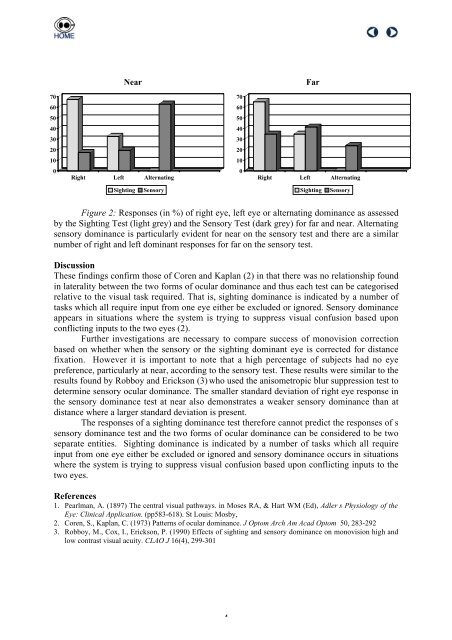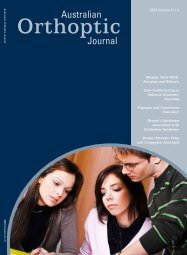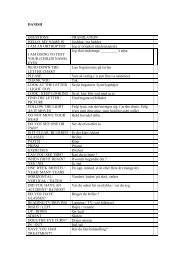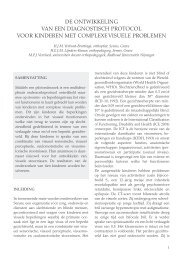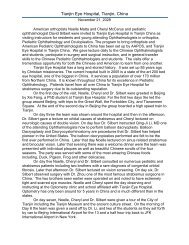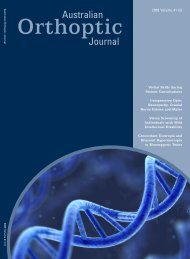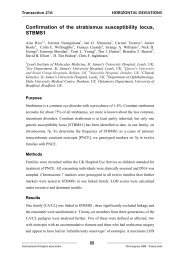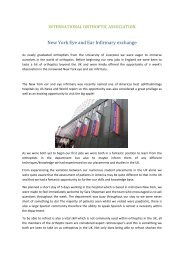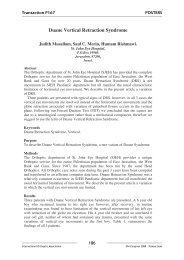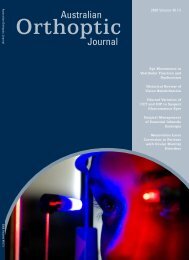Transactions from the Xth International Orthoptics Congress 2004
Transactions from the Xth International Orthoptics Congress 2004
Transactions from the Xth International Orthoptics Congress 2004
You also want an ePaper? Increase the reach of your titles
YUMPU automatically turns print PDFs into web optimized ePapers that Google loves.
Near<br />
Far<br />
70<br />
60<br />
50<br />
40<br />
30<br />
20<br />
10<br />
0<br />
Right Left Alternating<br />
70<br />
60<br />
50<br />
40<br />
30<br />
20<br />
10<br />
0<br />
Right Left Alternating<br />
Sighting<br />
Sensory<br />
Sighting<br />
Sensory<br />
Figure 2: Responses (in %) of right eye, left eye or alternating dominance as assessed<br />
by <strong>the</strong> Sighting Test (light grey) and <strong>the</strong> Sensory Test (dark grey) for far and near. Alternating<br />
sensory dominance is particularly evident for near on <strong>the</strong> sensory test and <strong>the</strong>re are a similar<br />
number of right and left dominant responses for far on <strong>the</strong> sensory test.<br />
Discussion<br />
These findings confirm those of Coren and Kaplan (2) in that <strong>the</strong>re was no relationship found<br />
in laterality between <strong>the</strong> two forms of ocular dominance and thus each test can be categorised<br />
relative to <strong>the</strong> visual task required. That is, sighting dominance is indicated by a number of<br />
tasks which all require input <strong>from</strong> one eye ei<strong>the</strong>r be excluded or ignored. Sensory dominance<br />
appears in situations where <strong>the</strong> system is trying to suppress visual confusion based upon<br />
conflicting inputs to <strong>the</strong> two eyes (2).<br />
Fur<strong>the</strong>r investigations are necessary to compare success of monovision correction<br />
based on whe<strong>the</strong>r when <strong>the</strong> sensory or <strong>the</strong> sighting dominant eye is corrected for distance<br />
fixation. However it is important to note that a high percentage of subjects had no eye<br />
preference, particularly at near, according to <strong>the</strong> sensory test. These results were similar to <strong>the</strong><br />
results found by Robboy and Erickson (3) who used <strong>the</strong> anisometropic blur suppression test to<br />
determine sensory ocular dominance. The smaller standard deviation of right eye response in<br />
<strong>the</strong> sensory dominance test at near also demonstrates a weaker sensory dominance than at<br />
distance where a larger standard deviation is present.<br />
The responses of a sighting dominance test <strong>the</strong>refore cannot predict <strong>the</strong> responses of s<br />
sensory dominance test and <strong>the</strong> two forms of ocular dominance can be considered to be two<br />
separate entities. Sighting dominance is indicated by a number of tasks which all require<br />
input <strong>from</strong> one eye ei<strong>the</strong>r be excluded or ignored and sensory dominance occurs in situations<br />
where <strong>the</strong> system is trying to suppress visual confusion based upon conflicting inputs to <strong>the</strong><br />
two eyes.<br />
References<br />
1. Pearlman, A. (1897) The central visual pathways. in Moses RA, & Hart WM (Ed), Adler s Physiology of <strong>the</strong><br />
Eye: Clinical Application. (pp583-618). St Louis: Mosby,<br />
2. Coren, S., Kaplan, C. (1973) Patterns of ocular dominance. J Optom Arch Am Acad Optom 50, 283-292<br />
3. Robboy, M., Cox, I., Erickson, P. (1990) Effects of sighting and sensory dominance on monovision high and<br />
low contrast visual acuity. CLAO J 16(4), 299-301<br />
4


